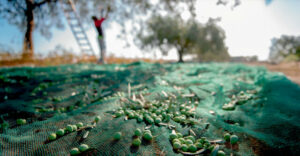Olive oil is now taking on epidemic proportions, fuelled by the high prices that persist, but also by the relatively low mood caused by climate change. As consumers look for ways to keep what Homer called the “golden liquid” from their tables, the unscrupulous are inventing increasingly dangerous methods to adulterate olive oil and sell it as “extra virgin” oil which may ultimately be contaminated and highly dangerous.
In addition to adulteration, a major problem is the extensive drought that is mainly affecting the world’s three largest olive oil producers (Spain, Italy, and Greece), cutting production. This is not only because olive groves are producing fewer olives, but mainly because the olives produced by the trees are smaller and dehydrated due to the very hot and dry weather.
This, as the farmers explain, has disastrous consequences. Firstly, on the quality of the oil (which they expect this year may not be at the same quality level as last year), but mainly on the production itself. This is because while last year 4 kg of olives produced 1 kg of olive oil, this year the ratio has changed: precisely because the olives are dehydrated, 10 kg of the fruit are needed to produce 1 kg of oil!
The amount of olives needed to produce 1 kg of olive oil is only 10 kg of olives to produce 1 kg of olive oil.
Low expectations
Producers are keeping a small basket, as it will all depend on how the weather goes next and how big the production will be. Spain expects to have a marginal increase in production this year with 1.3 million tonnes of olive oil – which, if confirmed, will help to deflate prices. The… news is not good from Italy, which expects a 32% drop in production this year (around 240,000-245,000 tonnes of total production), nor from Greece, with initial expectations of 200,000-240,000 tonnes of production abandoned. Certainly, however, it is better than last winter, when the country recorded one of its lowest production levels ever, not exceeding 150,000 tonnes.
The fact that the market is in a state of anticipation is demonstrated by the fact that the first commercial transaction this year for Agoura oil was at 10.5 euros per kilo, the same level as last year, while extra virgin olive oil is sold at 7.5 euros. Producers estimate that this year olive oil will reach consumers at around 9-10 euros a liter (compared to more than 13 euros last year), due to a 50% increase in fertilizer prices over the past two years and a surge in labor costs (from 35 euros a day in 2022, farm workers are paid more than 70 euros today for picking olives).
However, consumption is expected to prove to be a key determinant of the price of olive oil. As the 2024-25 crop is estimated to yield around 3 million tonnes of olive oil worldwide (compared to 2.5 million in 2023-24), it is a question of where demand will fluctuate amid increased supply. This is because the boom in the price of olive oil in the past two marketing seasons has led a significant portion of consumption, estimated at between 30%-40%, to switch to seed oils or reduce their consumption of olive oil.
Low sales
With olive oil prices risen by 57% (reaching as high as €16 per liter from €5.50 in November 2022), many consumers are looking for alternatives to get olive oil… old prices. The solution lies in street vendors, who however sell unlabelled oil, promising that it is extra virgin. And because, as the saying goes, “the wolf in disguise rejoices”, it’s not always the case.
What is very often recorded (and) in Greece, as in the rest of Europe, is that the oil that is smuggled in as “extra virgin” is ultimately unfit for human consumption. A typical case is the adulterated Cretan olive oil that was detected and seized in Denmark and Romania a few months ago.
As it turned out, it is olive oil that has been adulterated with oil from “leftovers” from an earlier harvest. The detail is that the “leftovers” from that harvest, two years ago, were left unsold because they were deemed unfit for consumption. That was when the olive groves of Crete had been hit by super blight and dengue, which could not be controlled with EU-approved pesticides. Thus, some farmers, faced with the risk of the entire crop being destroyed by the disease that strikes the trees, procured pesticides from third countries, which were imported and sold illegally, as their use is banned in Europe.
The crop for them was saved, but when the olive oil was sent for standardization and bottling, the EU-banned dangerous active substance of this particular drug was detected (in a laboratory in Great Britain). This was followed by sample checks by the Greek authorities, from which it emerged that the problem was ultimately a big one, as the substance was detected in a large part of the crop.
As of early 2023, of a total of 182 fraud and non-compliance notices with EU olive oil directives, 54 were for products from Italy, 41 from Spain, and 39 from Greece. The most common adulteration is therefore that olive oil is mixed with cheap seed oils, chlorophyll, and paints, with mineral oils or oil for oil lamps (!), with poor quality and unfit for human consumption oils from third countries, even contaminated with pesticides and even with glass fragments, which the authorities find in every corner of Europe.
In Greece, it is becoming increasingly common for street vendors to sell olive oil in five-liter cans, which should be thrown away, as it comes from previous harvests and has oxidized, or is prohibited to be sold as it contains high concentrations of banned pesticides and other harmful substances.

How to locate
In some cases, it’s probably impossible not to realize that you’ve been victimized and bought oil that is adulterated or contaminated. For example, if the olive oil purchased is adulterated with “Labonte”, which is fuel for oil lamps, there is an unpleasant smell. Even if one tries it, one will find that it is probably impossible to consume it, as it tastes very bad. But not all cases are the same.
The most basic indication of intolerance in olive oil is its color, which, depending on the variety of oil, can range from light to dark green, and its usually bitter or spicy taste with the characteristic fruity olive smell. The smell of fried potatoes is an indication that sunflower oil has been adulterated with sunflower oil. However, as farmers explain to ‘THEMA’, very often, even if the olive oil is adulterated by 50%, it is very likely that one will not be able to tell the difference visually and taste-wise. This is because the oil has the property of homogenizing when mixed with other oils, especially seed oils.
A simple way to tell if the oil you have purchased is adulterated, even if only slightly, is by a refrigerator test. Because pure olive oil tends to freeze (acquiring a buttery texture and appearance) when refrigerated because it contains a lot of monounsaturated fat, a simple way to test is to put it in a plastic cup or bottle in the refrigerator. If it’s adulterated, it won’t freeze. There’s also the… old-fashioned pitcher’s test, in which the olive oil is burned in its entirety if it’s not adulterated. Another way to get suspicious is to check the packing house code.
Since all legal olive oil packing plants have a code that starts with the letters EL followed by their number, all it takes is typing the packing plant code into an Internet search engine to find where the oil was packaged. If the production and packaging distances do not coincide and the taste or aroma of the purchased olive oil is not satisfactory, it is then advisable to contact a chemical laboratory. There, an analysis of the K and acidity values will show what it is all about.
Ioannis Pasias, PhD in Chemistry from the University of Athens, explains: “When the oil is adulterated with seed oil, the acidity value will be really low, as seed oils are low acidity and the K270 will be very high. Then, once you get the official results report, contact the EFET and report the adulteration. If you are not buying packaged olive oils with their respective nutritional labeling, then you should have confidence in the producer or intermediary from whom you buy them. In the market, there are olive oils adulterated with seed oils or nuclear oils, which are often dangerous for our health.”
Why adulterated oil is not… worth it
As scientists explain, by buying adulterated olive oil, not only does one put their health and that of their family at risk, but, at best, they miss out on the beneficial properties of “liquid gold” or the “great healer,” as Hippocrates called olive oil. What are they?
“Olive oil”, explains Dr. George-Alvertos Karikas to “THEMA”, “contains a mixture of compounds of distinct biological value, with remarkable bioactive properties that have been recognized and adopted internationally by a multitude of scientific studies. These beneficial means of maintaining our health are due to components of the olive fruit (Olea Europaea).”
The main fatty acids in olive oil are stearic and palmitic (saturated), oleic and palmitoleic (monounsaturated), linoleic and linolenic (polyunsaturated), in addition to sugars, proteins and minerals, it contains small quantities of free fatty acids, lecithins, sterols, phenols, tocopherols, tocopherols, pigments and various resinous and gelatinous substances.
It also contains oleuropein, which gives it its characteristic bitter taste and, along with its other antioxidants, reduces oxidative damage and oxidative stress in the body, and oleocanthal (which causes burning when swallowed) with anti-inflammatory and antioxidant properties similar to the well-known non-steroidal anti-inflammatory ibuprofen.
“The ideal combination of antioxidant-anti-inflammatory action of the phenolic components of extra virgin oil, which binds chronic overproduction of ROS (free oxidative radicals from pollution, smoking, etc, which attack DNA and cause premature aging and diseases such as dementia and Parkinson’s disease), has now been recognized to reduce the risk of a host of serious conditions, including cardiovascular disease, cancers, chronic inflammation, degenerative diseases, etc.”
Ask me anything
Explore related questions





